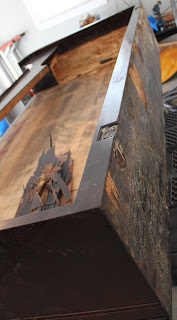...you might as well fill it to the brim with good stuff!
A friend of mine who lives and works (and drinks) in Asia
(hey Steve!) recently posted a nice shot of bar that had an impressive array of
potions and medicines. As I was looking at it, however, while I wouldn't say I
was unimpressed, I got the feeling that my home bar had as much, and possibly
more, liquor as the bar my friend was drinking at. Although my bar lacks
diversity within ingredient categories (for instance, I normally don’t stock
more than one gin, or vodka, or such at one time), it makes up for this in
sheer breadth of scope and overall quantity. (After all, this is a bar, at my
house, not an establishment open for business.) Anyway, here’s the bar stock
just before the holidays, so you can judge for yourself. As much as booze and
jazz go together, after this entry, I’ll stick to drinking booze and writing
about jazz.
 |
| Hard to see everything, because the small bottles disappear under the front rim of the piano, but they'd be obscured by bigger bottles if you put them in the back. |
Very back row, left to right: Romariz Colheita Port, Vintage 1963 (in
the wood box, same age as me – I was told it would be best after it was 50 years
old, so we get to drink it after my birthday next year), Choya plum wine,
Crystal Head vodka (in the skull right under the light, personalized and signed
by the distillery owner, Dan Ackroyd), Hibiki 17-year single malt whiskey,
peach brandy (in Paul Masson re-purposed brandy bottle), Tuaca, Cherry Heering,
Grenadine, Benedictine, Bombay Sapphire gin (x 2 - a man needs his gin), Jack Daniels (x 2 - a man needs his JD),
Cointreau, Gran Marnier (x 2 - a man needs his...you know), Jack Daniels single barrel whiskey, X.O. brandy
(in repurposed bottle, so I forget the brand, but I think it’s nothing too
special – which is to say, it’s not the Suntory I bought in Japan over the
summer because I drank that already), small bottle of Navan vanilla liqueur (I
think) that came with one of the Gran Marniers.
 |
| A little better to get the scope of 47 bottles, but still, wide enough that the camera can't focus in on every single bottle (still can't see the small ones down front, either) |
In the three crystal decanters (at right): Sandeman dry sherry,
Sandeman ruby port, vodka (no idea what brand, but it’s cheap stuff, probably
Smirnov)
Back row of the bottle well (L-R): Bols blue curacao, Bols
blackberry brandy, Bols crème de Cacao, cherry brandy, apricot brandy, Kubler
white absinthe, Lucid green absinthe (x 2 - a man...never mind), St. Germain elderflower liqueur
Middle row (L-R): Campari, Applejack, Aperol, Calvados (that’s
three apple drinks in a row), Kahlua, Old New Orleans spiced rum, Bacardi dark
rum (in re-purposed Old New Orleans bottle), Bacardi white rum (also in Old New
Orleans bottle)
Front row (L-R): Angostura bitters, Sauza agave tequila,
Pepe Lopez triple sec (thereby closing out the Mexican section of the bar),
Laphroig single malt, Alize Coco coconut liqueur, Wild Turkey rye whisley,
Bailey’s Irish Cream (x 2 - my woman, Mrs. S, needs her Bailey's), Calvados (extra)
So, that’s 47 bottles of booze by my count. Anybody thirsty
besides me?























































